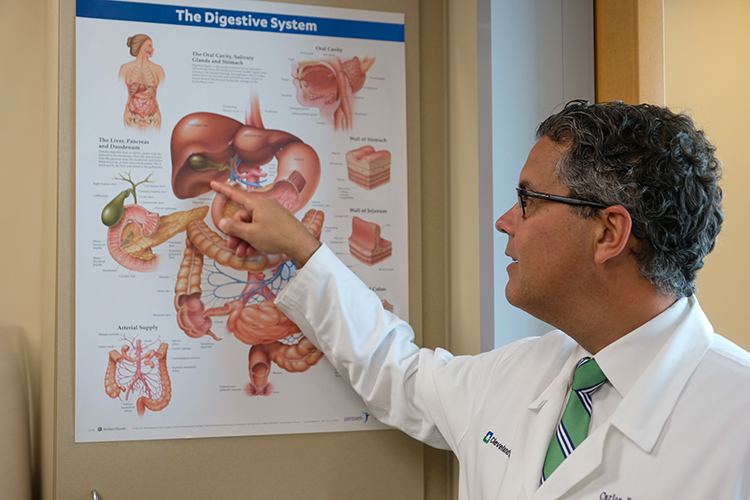
A new level of care for liver disease is available at Cleveland Clinic Martin Health at Tradition, where Dr. Carlos Romero arrived six months ago to develop a program that offers world-class treatment for all forms of liver disease and access to liver transplant services.
The newly established Center for Liver Disease at Cleveland Clinic Martin Health will be modeled on the renowned Mikati Center for Liver Diseases at Cleveland Clinic’s Digestive Disease Institute in Cleveland Ohio.
“My role is to deliver the best care at the right time to our patients with liver disease,” Dr. Romero said. “We have our sister hospital in Weston that has been doing liver transplants for five years and this area is very important as to how we grow our liver transplant program.
“My presence here is to improve the access for our Treasure Coast patients and to serve those patients that may need a liver transplant, sending them to Weston in a timely manner. Most importantly, we strive to prevent these patients from needing a liver transplant through preventative strategies to keep them from getting so sick that they need a new liver.
“My experience and training combined with good communication with the liver transplant team at Weston will ensure that the patient sees the right provider at the right time at the right place. We are trying to bring access to all liver services closer to home.”
Dr. Romero will build a multidisciplinary team of liver specialists to accurately diagnose and offer advanced treatments for all types of liver diseases aimed at preserving liver function and quality of life.
According to the American Liver Foundation, there are more than 100 different types of liver diseases but the progression of the disease typically looks the same regardless of the underlying cause. Early diagnosis is very important and may prevent irreversible liver damage from occurring. The liver is a resilient organ and can repair and regenerate itself, so damage from early stages of liver disease can often be reversed with a well-managed treatment plan.
A healthy liver is vital to life and you simply cannot live without one. The liver is an incredibly hard-working organ with more than 500 vital functions, including filtering the blood 24 hours a day. Only the brain has more functions than the liver.
Many of its functions are metabolic which allow you to convert food to energy, break down food to basic elements needed by your body and eliminate waste. Its main function is to filter your blood. At any given moment, your liver contains about a pint of blood, or 13 percent of the body’s total blood supply. Your liver filters more than a liter of blood every minute, which is about 22 gallons of blood per hour and more than 250 gallons of blood in a 24-hour period.
Common causes of liver disease are excessive alcohol consumption, viruses such hepatitis C and B, poor diet, obesity, reactions to medications, street drugs or other toxic chemicals, autoimmune diseases and genetics. The caveat is that most people who have liver disease have no idea they have it because they do not look or feel sick.
“The most common liver disease is fatty liver disease which affects 30 to 40 percent of the population, Dr. Romero explained. “Five percent of those with fatty liver disease may progress to cirrhosis of the liver, at which point it’s too late to reverse the damage. Two or 3 percent of the population has hepatitis B and 7 percent of population will have alcohol liver disease. Our goal is to figure out which patient will progress into advanced liver disease and which patients we can manage before it becomes critical.
“There are new treatments that can cure early stages of liver disease, so that’s why it’s so important to have a yearly checkup with a screening for hepatitis B and a blood panel workup to check your liver enzymes.”
There are four stages of liver disease:
Stage 1 is called fatty liver disease, and it occurs when fat deposits in and around the liver cause inflammation and swelling.
Stage 2 is hepatic fibrosis, during which time the liver swells and the liver cells harden.
Stage 3 is cirrhosis of the liver, which is severe scarring of liver cells.
Stage 4 is liver failure or liver cancer.
“Once a patient has cirrhosis their chance of developing liver cancer increases,” Dr. Romero continued. “Cirrhosis is scarring on the liver, which hardens the liver and restricts the blood flow. When the liver is functioning properly and the flow of blood is normal, it’s like driving a car at high speed. When it is diseased with cirrhosis it’s like a traffic jam. The blood will try to find detours and potential internal bleeding can occur.
Unfortunately, there is no treatment that can cure cirrhosis but treating the underlying cause may keep it from getting worse and help prevent liver failure.
“We’ve acquired a new machine that allows us to measure the amount of cirrhosis (or thickness of the liver) a patient has without a painful biopsy. The ultrasound-based machine is noninvasive and the results are immediate so we are able to interpret the results and formulate a plan. Generally, we’ll follow up with the patient with cirrhosis every six months to monitor the progression of the disease. We want to empower the patient to make sure they are aware of what can happen if they don’t take care of their liver health.”
Dr. Romero completed his medical school, residency and gastroenterology fellowship at the University of Puerto Rico. He subsequently completed an advanced fellowship in liver transplantation at Mayo Clinic at Rochester, Minnesota and spent 10 years as a staff physician at Cleveland Clinic in Ohio where he served as Chief of Hepatology. He is currently seeing patients at Center for Liver Disease at Cleveland Clinic Martin Health at Tradition, 1000 Innovation Way, Port St. Lucie. Call 772-398-1800 to schedule an appointment.



